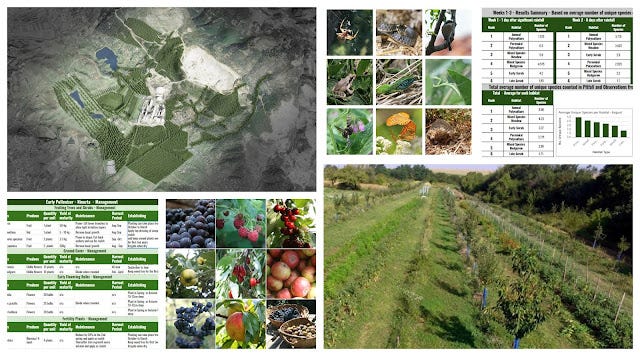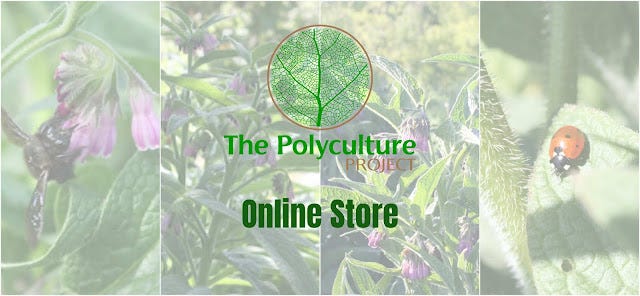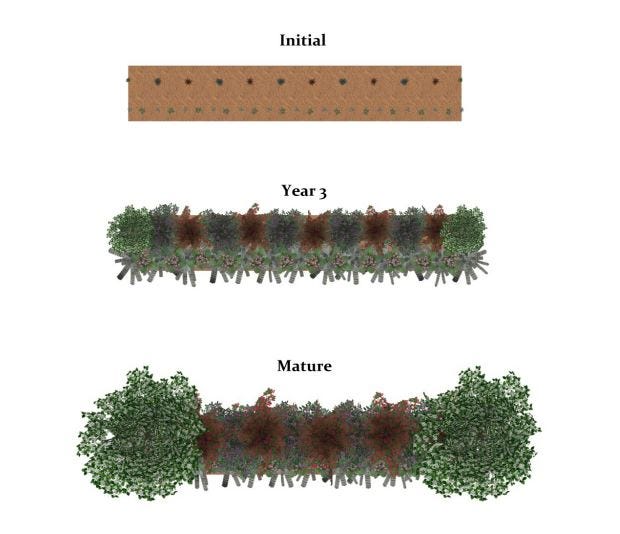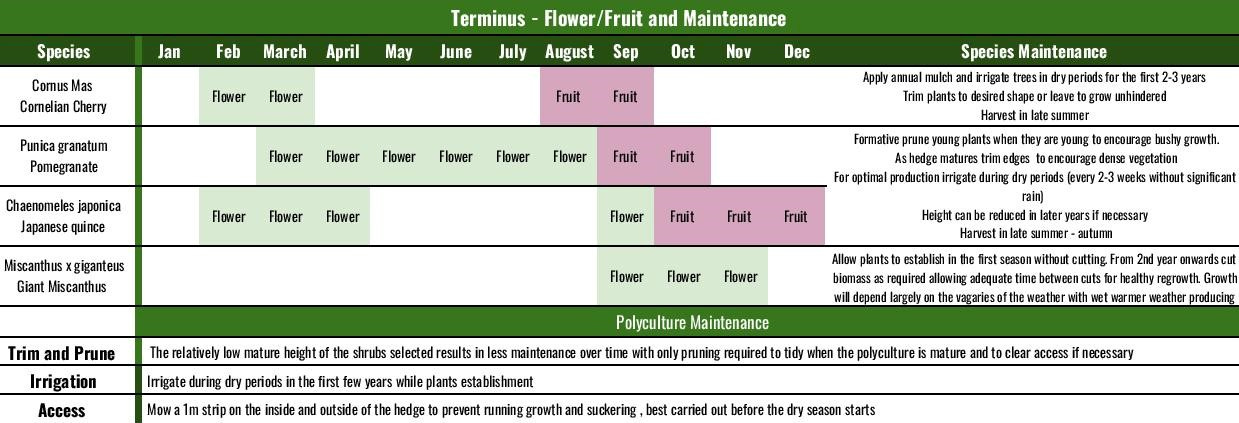Polyculture Profiles - A multifunctional Polyculture for your Forest Garden - Edibility/Windbreak/Biomass/Biodiversity - Terminus
Welcome to another post from our Polyculture Profile series where we will look at a four-species design that highlights well the multifunctionality of polyculture, providing an edible hedge, windbreak, and biomass resources all while enhancing biodiversity.
It will probably be helpful to look over this Polyculture Profile Layout post before or after reading, where we provide a description of the profile layout and some general notes to consider, should you wish to try to grow the polyculture yourself.
Polyculture Name - Terminus - Perennial Infrastructure
Intro - Named after the Roman God who protected boundary markers, the primary purpose of Terminus is to provide a low-growing/low-maintenance edible boundary hedge that, when mature, can keep livestock in/out (not including goats or drunk adolescent humans). Other purposes include biomass production, food/fodder production, pollination support for orchards and market gardens and habitat provision to a range of borgs (beneficial organisms). The polyculture can also serve as a fast forming wind break
Compatible Climate - (KCC) - C - D -B (with irrigation)
USDA Hardiness - 7 - 9 (For colder climates, swap out Punica granatum with Prunus spinosa)
Water Needs - Drought Tolerant - Irrigation required for optimal production
Light Preferences - Full Sun/Dappled Shade
Soil Preferences - light (sandy), medium (loamy), and heavy (clay)
Suitable pH: acid, neutral and alkaline
Layout - Border or Belt
N.B - We have not yet implemented this design at our site but we intend to once we are sure that the Pomegranate cultivars that were planted 2 years ago will survive a very cold winter here. The last few winters have been mild.
Overview Image
Regenerative Landscape Design - Online Interactive Course
Want to learn how to design, build and manage regenerative landscapes? Join us on our Regenerative Landscape Design - Online Interactive Course. We look forward to providing you with the confidence, inspiration, and opportunity to design, build and manage regenerative landscapes, gardens, and farms that produce food and other resources for humans while enhancing biodiversity.
You can access the course material at anytime and join the live sessions and interactive forums that run from May - Oct every year. All members of the Bloom Room receive a 500 EUR discount. To take up this offer all you have to do is become an annual subscribers to our Substack and register here with the promo code BLOOM.
I look forward to you joining !
Functional Components
This polyculture consists of three main components. A thorny and dense low-growing shrub hedge, standard trees, and a biomass strip on the inside of the hedge.
Low Growing Hedge - Punica granatum and Chaenomeles japonica make up the shrub layer, both plants have dense branching patterns and thorny spiny growth that can be encouraged with regular pruning resulting in an effective physical boundary that will not reach more than 3m at maturity. 2 rows of these plants may be required for keeping out larger animals.
Standard Trees - The standard trees used here Cornus mas can provide a reliable crop of fruit each year and are pretty much pest and disease free. The plant's mature height and width is 5m x 5m so they should not cast too much shade or hog too many resources from the surrounding area.
Biomass Strip - The inside of the hedge includes a biomass strip of Miscanthus x giganteus that can be cut at regular intervals for mulch supplies and will form a fast-growing visual barrier and windbreak if needed.
Boundary Hedging/Amenity Potential - The planting scheme is modular and can be repeated in the landscape to provide an almost instant visible boundary but will take 4 -6 years before be useful as a physical boundary. The Cornus mas standard trees take very well to trimming and if so desired can be shaped into pillars, irregular shapes or lifted the result of which can provide a visually interesting display to an entrance, perimeter or subdivision of a property.
Biomass Production Potential - Aside from biomass obtained from the strip of M.giganteaus, annual trimming of the shrubs and standard trees will also provide organic matter input. Mowing a 1m strip of the inside and outside of the hedge will also provide biomass. Some of the biomass is best left in situ to feed the plants within the hedge. As the Pomegranate and Japanese Quince establish and take on the role of hedging the Miscanthus can be cut back at more regular intervals and eventually cut back to the point that it will not grow back. This can be achieved via regular mowing of the new shoots
Food Production Potential - Pomegrante, Japanese quince, and Cornelian cherries can be harvested from the polyculture from the 4 or 5th year onwards (if using 1st-year saplings)
Habitat Potential - This polyculture provides a range of excellent and essential habitats. In terms of pollination support, Cornus mas provides one the best sources of early nectar/pollen often as early in the year as February with Punica granatum and Chaenomeles japonica following producing prolific blossoms throughout early spring - late summer. The density of the hedging at maturity will encourage abundant diverse insect fauna attracting a range of birds, mammals, and reptiles. The hedge should also provide habitat for bird and mammal nesting.

The biomass strip being cut at regular intervals will not provide too much habitat although below ground the regular perennial root shed of M.giganteus (2.5 meters deep ) will aerate the soil, adding organic matter and providing nutrients to worms and other soil life.
Windbreak Potential - The biomass strip can provide effective wind protection within a season. The other plants in the polyculture are all wind tolerant but will take 3 or 4 years to establish (with pruning). The Table below indicates how soon wind protection can be achieved with this polyculture and based on growth estimates the distance of land that can be protected from wind.
Access - The access to this polyculture wraps around the bed and should be a minimum of 50cm wide. Bare earth, grass, or other ground cover pathways are suitable.
Welcome to our Online Store where you can find Forest Garden/ Permaculture plants, seeds, bulbs, and Polyculture multi-packs along with digital goods and services such as Online Courses, Webinars and eBooks. We hope you enjoy the store and find something you like. It's your purchases that keep our Project going.
You can also find our full list of trees. shrubs and herbs for forest gardens on our nursery website.
Species List

You can find full plant profiles of these species in the links below. We have all of these plants available from our nursery
Chaenomeles speciosa - Japanese Quince
Cornus mas - Cornellian Cherry
Miscanthus x giganteus - Giant Miscanthus
We also have Miscanthus x giganteus rhizomes available from our online store here
and cultivars available for Cornellian Cherry and Pomegranate. Click on the banners below for details
Maturation Phases
Planting
The 80cm wide portion of the bed that will be planted with Miscanthus will perform better if compost is added to the surface of the bed at a rate of 20L per 2m length of bed for the first 2 years. This will provide the plants with a boost in growth as they establish the temporary windbreak
Additionally a layer of native spring ephemeral bulbs can be interplanted into the 1.2 m wide bed after planting the hedging and a nitrogen-fixing ground cover such as Trifolium repens can be sown into the disturbed soil.
Flower/Fruit and Annual Maintenance
Support Our Project
If you appreciate the work we are doing you can show your support in several ways.
Become a member of the Bloom Room. A $70 annual subscription to our Substack provides you with access to live sessions, design tutorials, a members forum and more, see details here.
Make a purchase of plants or seeds from our Nursery or Online Store
Joining us for one of our Practical Courses or Online Courses
Comment, like, and share our content on social media.
















